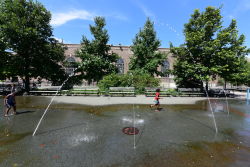Rev. T. Wendell Foster Park and Recreation Center
Reverend T. Wendell Foster Park
What was here before?
A creek, called Mentipathe by the Lenape, once ran through this land into the Harlem River, after following a course along what are now River and Jerome Avenues. When European settlers arrived, the creek was sold to John Cromwell in 1670 and renamed Cromwell’s Creek. It was filled in by 1910.
How did this site become a park?
The city acquired the land for this park on seven blocks to the east and west of Cromwell Avenue in 1924, followed by part of the Cromwell Avenue street bed in 1925. Four years later, East 162nd Street was moved eastward, expanding the acreage of Macombs Dam Park and cutting the acreage of this park.
This park was developed as a multi-use recreational facility that complements Macombs Dam Park to the south. It opened as a playground in 1932 and expanded over time. It was named Mullaly Park for John Mullaly, known as the father of the Bronx Park system, founding both the commission that established it and the city’s first parks advocacy group, the New York Park Association.
In the late 1960s, new recreational facilities were built, including a wading pool, swimming pool, bathhouse, ice rink and skate shop. Other additions in the early 1970s included tennis courts and softball fields. Since 1988, the bike park, which was formerly an ice rink, has been a popular feature with skateboarders, rollerbladers, and BMX riders.
Since 2001, Parks constructed two new playgrounds and two new mini soccer fields and athletic field with synthetic turf. In 2021, the recreation center was renovated with a new indoor basketball court, dance room, and library. Mullaly Park was renamed in 2021 due to Mullaly’s promulgation of racist views as editor of the Metropolitan Record.
Who is this park named for?
In 2021, as part of the second phase of NYC Parks’ initiative to expand the representation of African Americans honored in parks, this park was named for Reverend Wendell Foster (1924-2019), civil rights advocate and the first Black elected city official in the Bronx.
Born Windell Foster in Elba, Alabama, he was orphaned at age 12 and lived with his oldest brother in Birmingham. He attended local schools and graduated from Daniel Payne College.
Foster joined the Navy, and later studied at the University of Hawaii Armed Forces Educational Institute, Columbia University, and the Union Theological Seminary in New York City. Moving north, Foster lived first in Jersey City. He joined the Mt. Pisgah African Methodist Episcopal Church, became active in the civil rights movement, and was called to the ministry. He served as pastor at several congregations from 1952 to 1959 in Bermuda, where he met and married Helen Somersall.
In 1959, Foster settled in Springfield, Massachusetts and served as president of the local chapter of the NAACP. Foster ministered at the Mt. Zion A.M.E. Church in Harlem in 1962 but left to found the Christ Church. In 1963, he settled with his family in the Highbridge section of the Bronx. Facing discrimination and concerned about crime and quality of life in his community, in the 1970s Foster entered politics as an extension of his ministry.
In 1978, Foster became the first Black person to be elected to a city government position in Bronx County. As the Councilman of the 9th, and later 16th District, he championed low-income housing and served as longtime chair of the Parks Committee, promoting open spaces, including this one. He served 24 years through 2001 and was succeeded in elective office by his daughter Helen. Reverend Foster also co-founded the United Black Church Appeal to combat food insecurity and addiction, and helped found the Bronx Shepherds Restoration Corporation, which invests in improved borough housing.
Check out your park's Vital Signs
Clean & Safe
Green & Resilient
Empowered & Engaged Users
Share your feedback or learn more about how this park is part of a
Vital Park System










